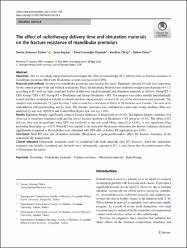| dc.contributor.author | Aktemur Türker, Sevinç | |
| dc.contributor.author | Kaşıkçı, Sena | |
| dc.contributor.author | Uzunoğlu Özyürek, Emel | |
| dc.contributor.author | Olcay, Keziban | |
| dc.contributor.author | Elmas, Özlem | |
| dc.date.accessioned | 2021-03-18T12:19:03Z | |
| dc.date.available | 2021-03-18T12:19:03Z | |
| dc.date.issued | 2021 | en_US |
| dc.identifier.citation | Aktemur Türker, S., Kaşıkçı, S., Uzunoğlu Özyürek, E., Olcay, K. ve Elmas, Ö. (2021). The effect of radiotherapy delivery time and obturation materials on the fracture resistance of mandibular premolars. Clinical Oral Investigations, 25(3), 901-905. https://dx.doi.org/10.1007/s00784-020-03378-2 | en_US |
| dc.identifier.issn | 1432-6981 | |
| dc.identifier.issn | 1436-3771 | |
| dc.identifier.uri | https://dx.doi.org/10.1007/s00784-020-03378-2 | |
| dc.identifier.uri | https://hdl.handle.net/20.500.12511/6625 | |
| dc.description.abstract | Objectives This ex vivo study was performed to investigate the effect of radiotherapy (RT) delivery time on fracture resistance of mandibular premolars filled with Biodentine or gutta-percha/sealer (GPS). Materials and methods Seventy-two mandibular premolars were used in this study. Randomly selected 24 teeth were kept intact for the control groups (with and without irradiation). Then, the remaining 48 teeth were randomly assigned into 4 groups (n = 12) according to RT delivery time (irradiated before or after root canal treatment) and obturation materials as follows: Group RT + GPS, Group: GPS + RT, Group RT + Biodentine and Group Biodentine + RT. The samples were either initially endodontically treated and then irradiated or initially irradiated and then endodontically treated with one of the abovementioned materials. The samples were irradiated at 2 Gy per fraction, 5 times a week for a total dose of 60 Gy in 30 fractions over 6 weeks. The roots were embedded in self-polymerizing acrylic resin. The fracture resistance was evaluated in a universal testing machine. Data was analyzed by one-way ANOVA and Games-Howell post hoc test atp < 0.05. Results Radiation therapy significantly reduced fracture resistance of intact teeth (p < 0.05). The highest fracture resistance was observed in intact/non-irradiated teeth and the lowest fracture resistance in Biodentine + RT group (p < 0.05). The effect of RT delivery time was insignificant when GPS was preferred as the root canal filling material (p > 0.05); it was significant when preferring Biodentine (p < 0.05). When RT was applied to the teeth after Biodentine obturation, the fracture resistance decreased significantly compared to the teeth that were obturated with GPS after or before RT application (p < 0.05). Conclusion Both RT time and obturation materials (Biodentine or gutta-percha/sealer) affect the fracture resistance of the endodontically treated teeth. | en_US |
| dc.language.iso | eng | en_US |
| dc.publisher | Springer | en_US |
| dc.rights | info:eu-repo/semantics/embargoedAccess | en_US |
| dc.subject | Biodentine | en_US |
| dc.subject | Endodontic Treatment | en_US |
| dc.subject | Fracture Resistance | en_US |
| dc.subject | Obturation Materials | en_US |
| dc.subject | Radiotherapy | en_US |
| dc.title | The effect of radiotherapy delivery time and obturation materials on the fracture resistance of mandibular premolars | en_US |
| dc.type | article | en_US |
| dc.relation.ispartof | Clinical Oral Investigations | en_US |
| dc.department | İstanbul Medipol Üniversitesi, Diş Hekimliği Fakültesi, Endodonti Ana Bilim Dalı | en_US |
| dc.authorid | 0000-0002-2168-710X | en_US |
| dc.identifier.volume | 25 | en_US |
| dc.identifier.issue | 3 | en_US |
| dc.identifier.startpage | 901 | en_US |
| dc.identifier.endpage | 905 | en_US |
| dc.relation.publicationcategory | Makale - Uluslararası Hakemli Dergi - Kurum Öğretim Elemanı | en_US |
| dc.identifier.doi | 10.1007/s00784-020-03378-2 | en_US |
| dc.identifier.wosquality | Q1 | en_US |
| dc.identifier.scopusquality | Q1 | en_US |


















